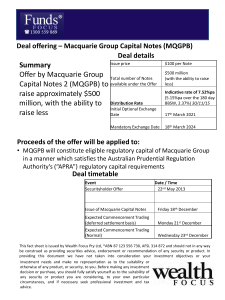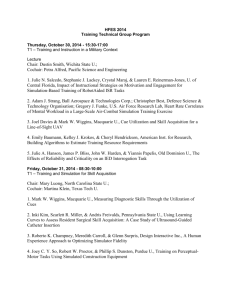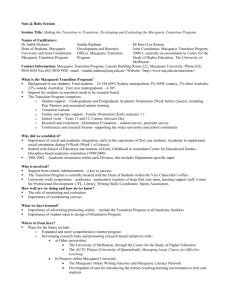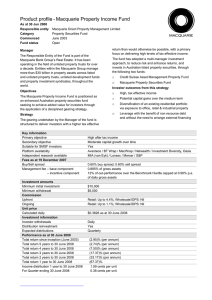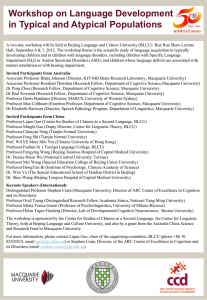Melbourne Cup Quant Style So you think you can win? AUSTRALIA Event
advertisement
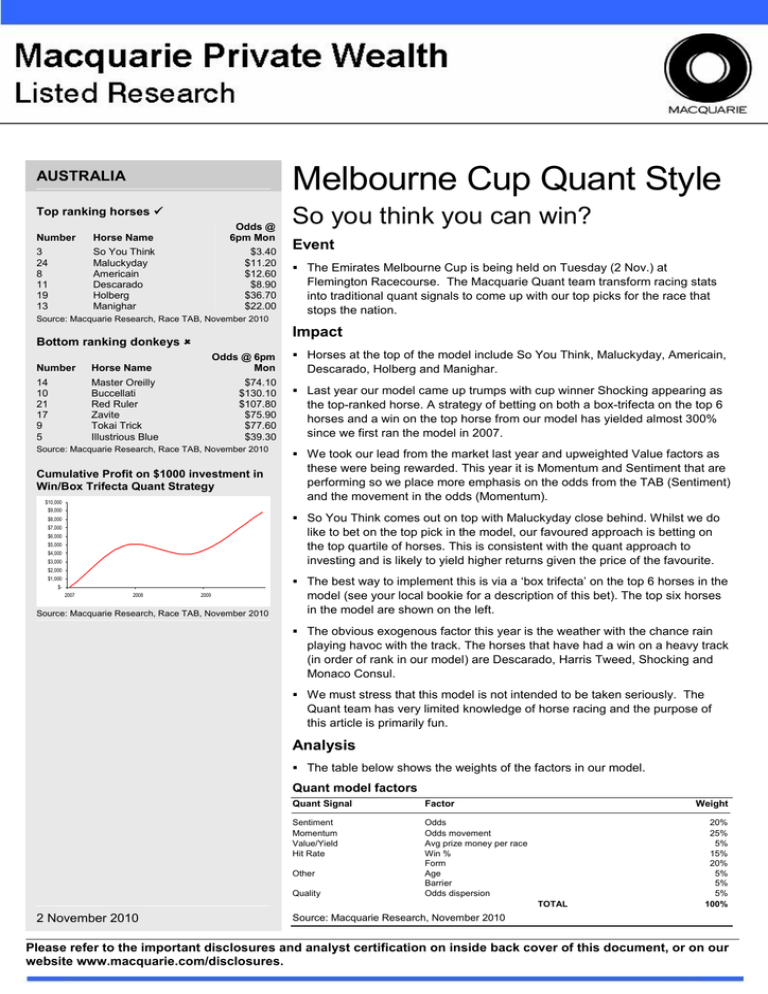
Melbourne Cup Quant Style AUSTRALIA Top ranking horses Number Horse Name Odds @ 6pm Mon 3 24 8 11 19 13 So You Think Maluckyday Americain Descarado Holberg Manighar $3.40 $11.20 $12.60 $8.90 $36.70 $22.00 Source: Macquarie Research, Race TAB, November 2010 Horse Name 14 10 21 17 9 5 Master Oreilly Buccellati Red Ruler Zavite Tokai Trick Illustrious Blue Event The Emirates Melbourne Cup is being held on Tuesday (2 Nov.) at Flemington Racecourse. The Macquarie Quant team transform racing stats into traditional quant signals to come up with our top picks for the race that stops the nation. Impact Bottom ranking donkeys Number So you think you can win? Odds @ 6pm Mon $74.10 $130.10 $107.80 $75.90 $77.60 $39.30 Source: Macquarie Research, Race TAB, November 2010 Cumulative Profit on $1000 investment in Win/Box Trifecta Quant Strategy $10,000 $9,000 Horses at the top of the model include So You Think, Maluckyday, Americain, Descarado, Holberg and Manighar. Last year our model came up trumps with cup winner Shocking appearing as the top-ranked horse. A strategy of betting on both a box-trifecta on the top 6 horses and a win on the top horse from our model has yielded almost 300% since we first ran the model in 2007. We took our lead from the market last year and upweighted Value factors as these were being rewarded. This year it is Momentum and Sentiment that are performing so we place more emphasis on the odds from the TAB (Sentiment) and the movement in the odds (Momentum). So You Think comes out on top with Maluckyday close behind. Whilst we do $8,000 $7,000 like to bet on the top pick in the model, our favoured approach is betting on the top quartile of horses. This is consistent with the quant approach to investing and is likely to yield higher returns given the price of the favourite. $6,000 $5,000 $4,000 $3,000 $2,000 The best way to implement this is via a „box trifecta‟ on the top 6 horses in the $1,000 $2007 2008 2009 Source: Macquarie Research, Race TAB, November 2010 model (see your local bookie for a description of this bet). The top six horses in the model are shown on the left. The obvious exogenous factor this year is the weather with the chance rain playing havoc with the track. The horses that have had a win on a heavy track (in order of rank in our model) are Descarado, Harris Tweed, Shocking and Monaco Consul. We must stress that this model is not intended to be taken seriously. The Quant team has very limited knowledge of horse racing and the purpose of this article is primarily fun. Analysis The table below shows the weights of the factors in our model. Quant model factors Quant Signal Factor Sentiment Momentum Value/Yield Hit Rate Odds Odds movement Avg prize money per race Win % Form Age Barrier Odds dispersion Other Quality Weight TOTAL 2 November 2010 20% 25% 5% 15% 20% 5% 5% 5% 100% Source: Macquarie Research, November 2010 Please refer to the important disclosures and analyst certification on inside back cover of this document, or on our website www.macquarie.com/disclosures. Macquarie Private Wealth Melbourne Cup Quant Style Analysis The table below shows the breakdown for each horse on each of the different factors we use in the model. Fig 1 Rank 1 2 3 4 5 6 7 8 9 10 11 12 13 14 15 16 17 18 19 20 21 22 23 24 Detailed rankings DETAILS # Horse Name 3 24 8 11 19 13 12 20 1 23 4 7 2 15 16 22 6 18 5 9 17 21 10 14 OS MAX SCORE So You Think Maluckyday Americain Descarado Holberg Manighar Harris Tweed Precedence Shocking Once Were Wild Zipping Shoot Out Campanologist Monaco Consul Profound Beauty Linton Mr Medici Bauer Illustrious Blue Tokai Trick Zavite Red Ruler Buccellati Master Oreilly Age Barrier Odds NZ NZ FRA NZ UAE ENG NZ NZ UAE NZ IRE HKG ENG ENG JPN NZ NZ NZ 4 4 6 4 5 5 5 5 5 4 9 4 6 4 7 4 6 8 8 9 8 6 7 8 3 6 12 1 10 20 13 15 24 11 16 17 19 14 22 23 5 2 9 4 7 8 21 18 $ $ $ $ $ $ $ $ $ $ $ $ $ $ $ $ $ $ $ $ $ $ $ $ 3.40 11.20 12.60 8.90 36.70 22.00 17.90 22.80 12.20 26.70 23.50 17.10 67.00 36.00 38.10 65.20 46.00 51.40 39.30 77.60 75.90 107.80 130.10 74.10 VALUE HIT RATE Prize Money Form 5 20 5 2.5 2.5 5 1.25 2.5 2.5 1.25 5 1.25 3.75 5 3.75 5 2.5 3.75 3.75 3.75 1.25 5 2.5 1.25 1.25 3.75 20 20 20 15 20 10 15 20 10 10 15 10 20 10 20 20 10 10 15 15 5 5 5 5 Win % 15 15 15 11.25 7.5 15 15 3.75 7.5 7.5 15 11.25 11.25 11.25 7.5 15 11.25 3.75 11.25 3.75 3.75 3.75 7.5 7.5 3.75 SENTIMENT MOMENTUM RISK OTHER Odds Odds Movement Odds Dispersion Age Barrier Total Score 20 25 5 5 5 100 20 20 20 20 10 15 15 15 20 15 15 20 5 15 10 10 10 10 10 5 5 5 5 5 25 25 25 25 18.75 25 25 18.75 18.75 12.5 18.75 12.5 18.75 12.5 6.25 6.25 18.75 12.5 6.25 6.25 12.5 6.25 12.5 6.25 5 5 5 3.75 2.5 3.75 3.75 5 5 5 3.75 2.5 3.75 2.5 3.75 1.25 2.5 2.5 2.5 1.25 1.25 1.25 1.25 1.25 5 5 2.5 5 5 5 5 5 5 5 0 5 2.5 5 0 5 2.5 0 0 0 0 2.5 0 0 5 5 5 5 5 0 5 0 0 5 0 0 0 5 0 0 5 5 5 5 5 5 0 0 100 97.5 91.25 86.25 77.5 76.25 75 72.5 71.25 68.75 67.5 66.25 65 62.5 57.5 57.5 56.25 55 43.75 41.25 35 33.75 32.5 25 Source: Macquarie Research, Race TAB, November 2010 Sentiment was measured by the last available odds before publication as this is representative of the mood of the market. Horses with strong sentiment include So You Think, Shocking, Maluckyday and Americain. Momentum was measured by movement in the odds from opening prices until the latest available odds. Horses with strong momentum include So You Think, Maluckyday, Americain and Profound Beauty. Value was measured by average prize money per race as this represents the return of each horse. Leaders in this category were So You Think, Shocking, Descarado and Tokai Trick. Hit rate was measured by the horses winning percentage and by the form over the last five races for the horse. Horses with a good hit rate include So You Think, Maluckydday, Linton and Profound Beauty. Quality/Risk was measured by odds dispersion amongst bookmakers to indicate the variance of the perceived value of the horses. Horses with low odds dispersion are So you think, Mr Medici, Americain and Manighar. We also took into account factors that made up previous winners of the Melbourne Cup. Starting barrier can give the horse an obvious advantage. According to historical analysis, winning horses are almost twice as likely to have started in one of the first 14 barriers. The age of the horse can also make a difference. Almost half of winners since 1861 have been aged four or five. A horse‟s weight handicap showed no correlation and was therefore left out of the model. 2 November 2010 2 Macquarie Private Wealth Melbourne Cup Quant Style Historic Profitability of the model The Macquarie Quant team first ran the Melbourne Cup model in 2007. Taking a box trifecta on the Top 6 horses in the model in 2007 paid handsomely. In 2008, we warned to be wary of the „Black Swan‟ and unfortunately our model yielded little success. At $41, Viewed came from nowhere to win the cup. Most of the race favourites were left behind. In 2009, Shocking was at the top of our model and took out the race. We like a bet on the top pick in the model; however, our favoured approach is betting on the top quartile of horses. This is consistent with the quant approach to investing. The best way to implement this is via a „box trifecta‟ on the top 6 horses in the model (see your local bookie for a description of this bet) and this has yielded success in the past. The top six horses in the model are shown on the left. Below we show the profitability of betting a combined $1000 on 2 bets in each of the years we‟ve run the model: The top-ranked horse for a win A box-trifecta on the top six horses in the model. Fig 2 Cumulative Profit on an anual $1000 investment in Win/Box Trifecta Quant Strategy $10,000 $9,000 $8,000 $7,000 $6,000 $5,000 $4,000 $3,000 $2,000 $1,000 $2007 2008 2009 Source: Macquarie Research, Race TAB, November 2010 This strategy has yielded almost 300% since we first ran the model in 2007. We must stress again however that this model is not intended to be taken seriously. The Quant team has very limited knowledge of horse racing and the purpose of this article is primarily fun. And… Past performance is no indication of future returns. Happy punting! 2 November 2010 3 Macquarie Private Wealth Important disclosures: Melbourne Cup Quant Style Recommendation definitions Volatility index definition* Financial definitions Macquarie - Australia/New Zealand Outperform – return >3% in excess of benchmark return Neutral – return within 3% of benchmark return Underperform – return >3% below benchmark return This is calculated from the volatility of historical price movements. All "Adjusted" data items have had the following adjustments made: Added back: goodwill amortisation, provision for catastrophe reserves, IFRS derivatives & hedging, IFRS impairments & IFRS interest expense Excluded: non recurring items, asset revals, property revals, appraisal value uplift, preference dividends & minority interests Benchmark return is determined by long term nominal GDP growth plus 12 month forward market dividend yield Macquarie – Asia/Europe Outperform – expected return >+10% Neutral – expected return from -10% to +10% Underperform – expected return <-10% Macquarie First South - South Africa Outperform – expected return >+10% Neutral – expected return from -10% to +10% Underperform – expected return <-10% Macquarie - Canada Outperform – return >5% in excess of benchmark return Neutral – return within 5% of benchmark return Underperform – return >5% below benchmark return Macquarie - USA Outperform (Buy) – return >5% in excess of Russell 3000 index return Neutral (Hold) – return within 5% of Russell 3000 index return Underperform (Sell)– return >5% below Russell 3000 index return Very high–highest risk – Stock should be expected to move up or down 60–100% in a year – investors should be aware this stock is highly speculative. High – stock should be expected to move up or down at least 40–60% in a year – investors should be aware this stock could be speculative. Low–medium – stock should be expected to move up or down at least 25–30% in a year. EPS = adjusted net profit / efpowa* ROA = adjusted ebit / average total assets ROA Banks/Insurance = adjusted net profit /average total assets ROE = adjusted net profit / average shareholders funds Gross cashflow = adjusted net profit + depreciation *equivalent fully paid ordinary weighted average number of shares Low – stock should be expected to move up or down at least 15–25% in a year. * Applicable to Australian/NZ/Canada stocks only All Reported numbers for Australian/NZ listed stocks are modelled under IFRS (International Financial Reporting Standards). Medium – stock should be expected to move up or down at least 30–40% in a year. Recommendations – 12 months Note: Quant recommendations may differ from Fundamental Analyst recommendations Recommendation proportions – For quarter ending 30 September 2010 Outperform Neutral Underperform AU/NZ 51.06% 34.15% 14.79% Asia 64.41% 17.31% 18.28% RSA 55.07% 36.23% 8.70% USA 46.58% 48.40% 5.02% CA 66.99% 28.71% 4.31% EUR 50.00% (for US coverage by MCUSA, 13.73% of stocks covered are investment banking clients) 36.81% (for US coverage by MCUSA, 11.76% of stocks covered are investment banking clients) 13.19% (for US coverage by MCUSA, 0.00% of stocks covered are investment banking clients) Company Specific Disclosures: Important disclosure information regarding the subject companies covered in this report is available at www.macquarie.com/disclosures. General Disclaimers: This research has been issued and distributed in Australia by Macquarie Equities Limited ABN 41 002 574 923 ("MEL"). MEL holds Australian Financial Services Licence No. 237504 and is a Participant of the Australian Securities Exchange Group. MEL is not an authorised deposit-taking institution for the purposes of the Banking Act (Cth) 1959 and MEL's obligations do not represent deposits or other liabilities of Macquarie Bank Limited ABN 46 008 583 542. Macquarie Bank Limited does not guarantee or otherwise provide assurance in respect of the obligations of MEL. This research has been prepared for the use of the clients of Macquarie Group Limited and its related entities (the "Macquarie Group") and must not be copied, either in whole or in part, or distributed to any other person. If you are not the intended recipient, you must not use or disclose the information in this research in any way. Nothing in this research shall be construed as a solicitation to buy or sell any security or product, or to engage in or refrain from engaging in any transaction. This research is general advice and does not take account of your objectives, financial situation or needs. Before acting on this general advice you should therefore consider the appropriateness of the advice having regard to your situation. We recommend you obtain financial, legal and taxation advice before making any financial investment decision. There are risks involved in securities trading. The price of securities can and does fluctuate and an individual security may even become valueless. International investors are reminded of the additional risks inherent in international investments, such as currency fluctuations and international stock market or economic conditions, which may adversely affect the value of the investment. This research is based on information obtained from sources believed to be reliable but we do not make any representation or warranty that it is accurate, complete or up to date. We accept no obligation to correct or update the information or opinions in it. Opinions expressed are subject to change without notice. No member of the Macquarie Group accepts any liability whatsoever for any direct, indirect, consequential or other loss arising from any use of this research and/or further communication in relation to this research. The Macquarie Group or its associates (including MEL), officers or employees may have interests in the financial products referred to in this report by acting in various roles including as investment banker, underwriter or dealer, holder of principal positions, broker, lender, director or adviser. Further, they may act as market maker or buy or sell those securities as principal or agent and, as such, may effect transactions which are not consistent with the recommendations (if any) in this research. The Macquarie Group or its associates (including MEL) may receive fees, brokerage or commissions for acting in those capacities and the reader should assume that this is the case. The analyst(s) principally responsible for the preparation of this research receives compensation based on overall revenues, including investment banking revenues of Macquarie Group Limited and its related entities. This research has been issued and distributed in New Zealand by Macquarie Equities New Zealand Limited (“MENZ”) an NZX Firm. Macquarie Private Wealth's (MPW) services in New Zealand are provided by MENZ. Macquarie Bank Limited ABN 46 008 583 542 ("MBL") is a company incorporated in Australia and authorised under the Banking Act 1959 (Australia) to conduct banking business in Australia. Neither MBL nor any member of the Macquarie Group, including MENZ are registered as a bank in New Zealand by the Reserve Bank of New Zealand under the Reserve Bank of New Zealand Act 1989. Any Macquarie subsidiary noted in this document is not an authorised deposit-taking institution for the purposes of the Banking Act 1959 (Australia). That subsidiary‟s obligations do not represent deposits or other liabilities of MBL. MBL does not guarantee or otherwise provide assurance in respect of the obligations of that subsidiary, unless noted otherwise. Disclosures with respect to issuers, if any, mentioned in this research are available at www.macquarie.com.au/disclosures, or can be obtained from your Macquarie representative. © Macquarie Group 2 November 2010 4
